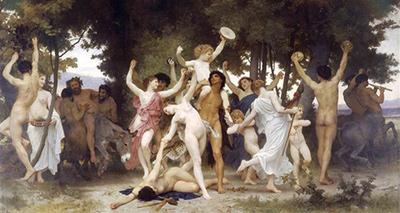William-Adolphe Bouguereau painted The Youth of Bacchus (La Jeunesse de Bacchus) in 1884.
This huge work of art is about 130 inches wide and 240 inches high. It was created in oil on canvas in the neo-Classical style. The painting currently hangs in a private collection.
The Youth of Bacchus shows a scene of bacchanalia. This was a ritual of drinking and wild dancing that was a part of the Roman festival dedicated to the god, Bacchus. The painting depicts a group of naked or semi-clothed men and women dancing and playing musical instruments, together with mythical creatures such as satyrs, nymphs, cherubs and centaurs.
Despite the title of the painting referring to Bacchus’ youth, he is shown as a middle-aged man with a beard and a huge belly, who is obviously the worse for wear after drinking too much.
He is naked, apart from a strategically placed vine across his groin and a head-dress made from vine leaves. Bacchus is slumped on the back of an overladen and unhappy donkey.
He has an empty wine goblet dangling from one hand, while two satyrs struggle to support his body and keep him upright on the donkey. Bacchus is placed away from the foreground of the scene, where the younger, dancing figures are placed. They are painted in much lighter, brighter colours so that they stand out much more than Bacchus.
In the centre of the painting is a naked female figure who dances while lifting the hand of another naked female, who is lying at her feet, presumably having collapsed after drinking too much.
On the ground beside her is a Thyrsus, which was a staff made of fennel with a large pinecone on the end. This was traditionally carried by Bacchus and his followers. A female figure to the right also carries a Thyrsus. She wears white robes and dances with two naked cherubs, one of whom plays a triangle. A third naked cherub, holding a tambourine, is held aloft on the shoulders of a naked, dark-skinned satyr who holds the cherub’s legs to stop him from falling.
Several of the characters in the painting are holding wine glasses or bunches of grapes, including a semi-naked girl at the left who holds an upturned tambourine filled with grapes. A naked male character to the left is pulling vines and grapes from the trees above his head. Many different musical instruments can be seen in the painting. Two centaurs stand at the right of the painting and play pan-pipes, while various figures play castanets, cymbals and tambourines.
William-Adolphe Bouguereau was born into a family of wine makers, so the subject matter of this painting was probably close to his heart. The French artist was famous for his skilled depiction of the naked female form, and he took a classic, Academic approach to painting.
He greatly admired Raphael, and other Old Masters. He achieved great success and fame during his lifetime, and won many awards, including becoming a Life Member of the French Academy and receiving the French Legion of Honor. Most of Bouguereau’s works depicted historical scenes from the classical world of Greece and Rome, although a series of paintings showing nude female bathers was also extremely popular with his wealthy clients.




